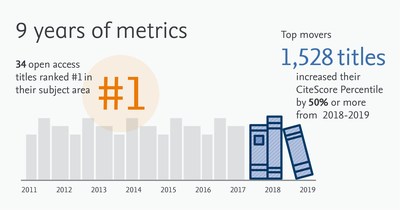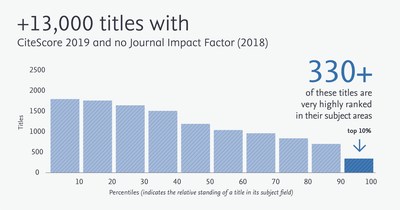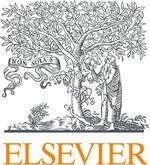
AMSTERDAM, June 23, 2020 /PRNewswire/ -- Elsevier, a global leader in research publishing and information analytics, today released the 2019 CiteScore values, its latest assessment of thousands of peer-reviewed research journals, book series, conference proceedings and trade publications covered in Scopus. In addition, an improved calculation methodology has been introduced to provide a more robust, fair and faster indicator of research impact.

This year more than 25,000 source titles covering 330 disciplines were ranked across eight indicators, which are all part of CiteScore metrics. These include: CiteScore, CiteScore Tracker, CiteScore Percentile, CiteScore Quartiles, CiteScore Rank, Citation Count, Document Count, and Percentage Cited. Calculating values for all titles included in Scopus, CiteScore covers nearly 13,000 more titles than the Impact Factor. Access to CiteScore metrics' underlying data is free for everyone, including non-Scopus subscribers, so values can be recalculated offering transparency to researchers, publishers and the wider academic community.
A new methodology has been used to calculate 2019 CiteScore values, four clear changes have been made:
- Only peer-reviewed publication types (articles, reviews, conference papers, book chapters and data papers) will be included in both the citation numerator and publication denominator, making the comparison between journals more robust. Previously, all publications were included in the calculations (non-peer reviewed article types like editorials, news items, letters, notes).
- Citations will now be counted cumulatively, from the year of publication until the end of the calculation window, which is up to four years. This means that all citations received by publications in this period are counted towards CiteScore values, allowing a more robust assessment. In the past, citations were counted for the previous year only.
- Publications in the four years up to and including the calculation year will now be included. This means that CiteScore can be calculated for journals with just a single year of publication, giving new journals - including many Open Access (OA) and China-focused journals - a first indication of their citation impact one year earlier.
- CiteScore values will be displayed to one decimal place in order to avoid an impression of precision, in line with industry best-practice. Previously, CiteScore values were displayed to two decimal places.
"Since we launched CiteScore in 2016, we have been in close contact with the research community, listening to feedback from researchers, research leaders, librarians, and journal editors," said Andrew Plume, Director of Market Intelligence, Elsevier. "We have acted on their collective feedback, introducing this new calculation to allow for a faster and more robust comparison of journals, while retaining the comprehensive, current and clear methodology that is appreciated so much."
With CiteScore Tracker journal performance can be monitored throughout the year, alongside the release of the annual score. For a complete overview of 2019 CiteScore values - and all other research metrics available in Scopus - go to: www.scopus.com/sources
CiteScore metrics are part of a collection of research metrics available on or through Scopus. Other metrics include journal, author, institutional, and article-level metrics captured in PlumX Metrics (covering Usage, Captures, Mentions, Social Media and Citations), supporting a holistic view of research performance.
CiteScore metrics, including access to the underlying data, are free to access without a Scopus subscription in the following ways:
- Scopus: Search and filter features let you explore the full range of CiteScore metrics for a group of journals (such as OA journals), a subject category or a publisher view. You can also access individual source profile pages and download the complete set of CiteScore metrics as a Microsoft Excel file.
- Journal Insight pages on Elsevier.com: Access CiteScore metrics and other journal metrics in categories Impact, Speed and Reach for more than 2,500 journals published by Elsevier.
About Elsevier
Elsevier is a global information analytics business that helps scientists and clinicians to find new answers, reshape human knowledge, and tackle the most urgent human crises. For 140 years, we have partnered with the research world to curate and verify scientific knowledge. Today, we're committed to bringing that rigor to a new generation of platforms. Elsevier provides digital solutions and tools in the areas of strategic research management, R&D performance, clinical decision support, and professional education; including ScienceDirect, Scopus, SciVal, ClinicalKey and Sherpath. Elsevier publishes over 2,500 digitized journals, including The Lancet and Cell, 39,000 e-book titles and many iconic reference works, including Gray's Anatomy. Elsevier is part of RELX, a global provider of information-based analytics and decision tools for professional and business customers. www.elsevier.com
Media contact
David Tucker
Elsevier Communications
Europe
+44-7920-536-160
d.tucker@elsevier.com
Photo 1:https://mma.prnewswire.com/media/1195051/Elsevier_Citescore_Infographic2020_9_years.jpg
Photo 2: https://mma.prnewswire.com/media/1195052/Elsevier_Citescore_Infographic2020_330Disciplines.jpg
Photo 3: https://mma.prnewswire.com/media/1195053/Elsevier_Citescore2020_Titles.jpg
Logo:https://mma.prnewswire.com/media/754760/Elsevier_Logo.jpg




